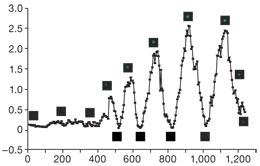-
horloge synthétique dans cellule animale vivante
http://www.nature.com/news/2009/090114/full/news.2009.23.html
Published online 14 January 2009 | Nature | doi:10.1038/news.2009.23
Genetic 'clock' made in lab
Synthetic metronome keeps time inside mammalian cells.
Swiss scientists have designed the genetic circuitry for a synthetic 'clock', inserted it into mammalian cells and used it to control the levels of a fluorescent protein.
The approach, which involves plugging genes together to create circuits not seen in nature, could allow scientists to one day make synthetic cellular metronomes that release drugs in precisely timed bursts.
It will also help scientists to understand natural 'oscillators', such as those that control our sleepwake cycle. "We were fascinated by these timekeeping devices and thought, to better understand them, we'd design a synthetic oscillator that acts like a natural one but has been composed of artificial components," explains Martin Fussenegger of the Swiss Federal Institute of Technology (ETH Zurich) in Basel, Switzerland, whose team carried out the experiments.
Such cellular timekeepers have been made to work inside bacterial cells1, but in more complex mammalian cells, the genetic networks have proven difficult to design.
Fussenegger and his colleagues have now managed to make an oscillator that turned the production of a fluorescent protein on and off in a hamster ovary cell and kept the cycle going for more than 20 hours2.
Making sense
As in previous approaches, the team took advantage of the genetic process of transcription, whereby a gene gets read out into the message that is then translated into a protein. Every gene actually consists of two pieces of DNA that are complementary to each other. If a gene is read forwards called 'sense' transcription the protein is generated in the normal way, but if the other, complementary strand is transcribed called antisense no protein is made.
 The circuit results in the cyclical expression of a fluorescent protein inside cells.Nature
The circuit results in the cyclical expression of a fluorescent protein inside cells.NatureThe circuit consists of bits of genetic code that order sense and then antisense transcription to be performed. The circuit also includes a sequence that makes green fluorescent protein so the team can easily tell if the circuit is working once it is inside a cell.
The circuit's starting sequence makes a protein called tTA, which does two things: it turns on the gene that makes green fluorescent protein, and another gene that makes a different compound, called PIT. PIT eventually shuts down the production of tTA until there's almost none left. The lack of tTA also means that PIT is no longer produced, and that allows the whole cycle to reset, with tTA production starting up again.
The team were also able to 'tune' the oscillator: inserting more of the genetic cassettes encoding the circuit increased the frequency of the oscillations; fewer decreased them. Their results are reported in Nature.
Time tool
Modelling oscillators and interfering with them also gives scientists insight into how nature's own metronomes work. "The problem with natural components is that they're inherently complicated and tied into the rest of a system," says Jeff Gore at the Massachusetts Institute of Technology in Cambridge, who has worked on similar projects in the past. "With synthetic systems you can make sure you really understand what's going on."
Such circuits may also have therapeutic potential in the future for example by regulating the levels of a particular protein or drug in the body. "One thing we are dreaming of is to have an oscillator express a protein such as insulin, and have it expressed every, say, six hours," says Fussenegger. "So we have an oscillator that could be not only a timekeeping device but also a kind of molecular production system."
Gore cautions that these applications are still far away but that this paper and other recent results have moved the field forwards. "Until it's built, you can't really say you understand it," he says.
-
References
-
-
Commentaires
Mon petit cahier de sciences naturelles

